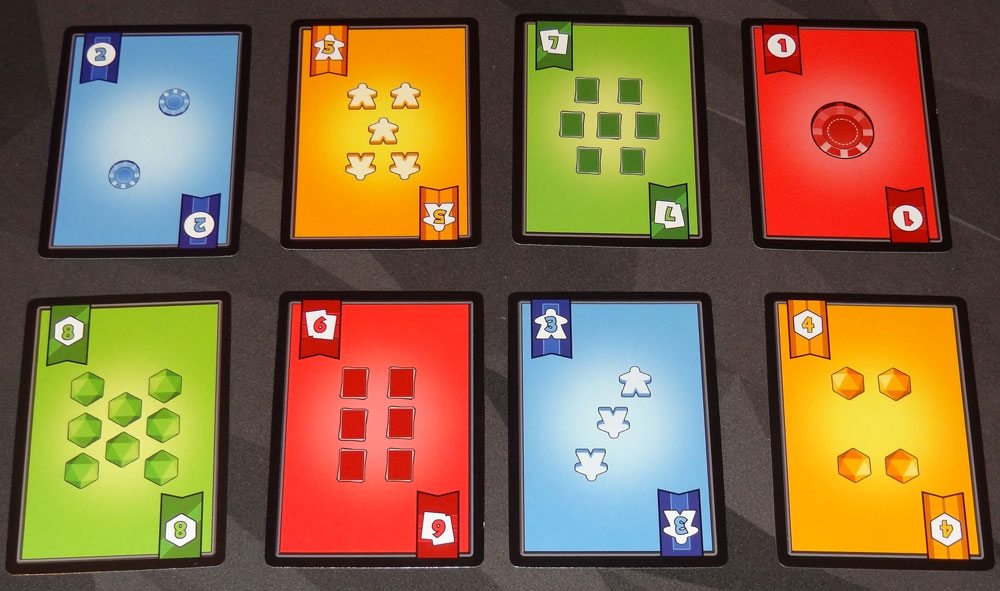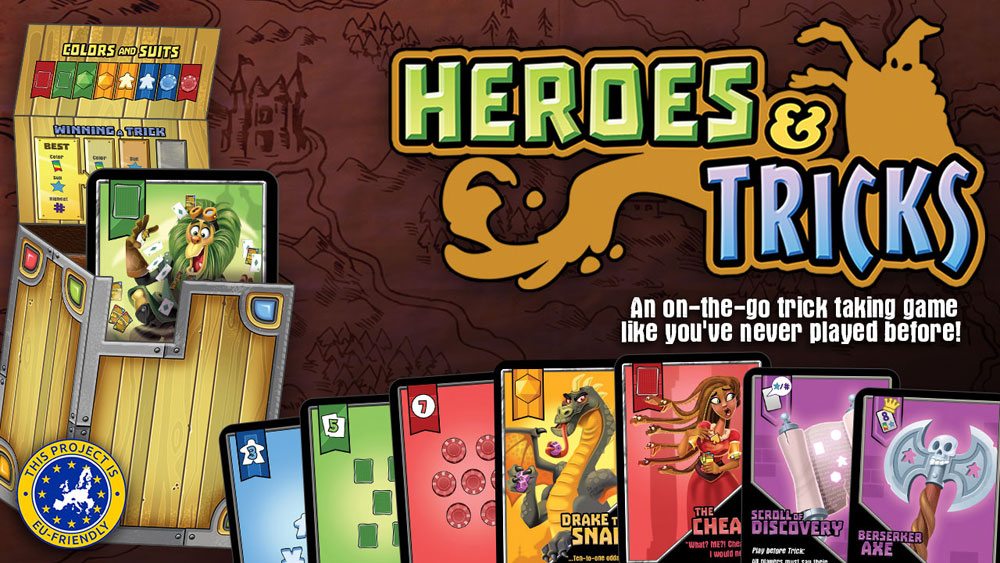If you like trick-taking games, here’s a card game with a new trick up its sleeve—or, rather, in its box: Heroes and Tricks.
At a glance: Heroes and Tricks is a game for 2 to 6 players, ages 8 and up, and takes about 20 minutes to play. It’s currently seeking funding on Kickstarter, with a pledge of $20 for a copy of the game. I’ve played the game with both kids and adults and the age rating seems pretty good.
New to Kickstarter? Check out our crowdfunding primer.

Components
- 1 game box
- 64 Play cards
- 16 Hero cards
- 28 Gear cards

Let’s talk about that game box first: normally I don’t include the box in a list of components, because, hey, every game comes with a box, right? I don’t include the rulebook, either, although every game comes with instructions, too. In this case, though, the box itself is a crucial part of the game. It’s made like a deck box with a magnetic flap on the lid. Under that flap is a small player reference guide. The flap also covers up a little cut-out window in the front of the box—when you place a card in the box, you can see the card’s index through the window. The box also has two dividers (the prototype only has one) to separate the current trick from the discards and the other cards. I gotta say—it’s pretty nifty, and I’m sad I’ll have to send the prototype back after writing up this review.

The Play cards are similar to a normal deck of playing cards, with suits and numbers, though with some variations. There are 4 suits (Meeple, Card, Chip, Die) and 4 colors (Blue, Red, Green, Orange): each suit is represented by two of the colors, and each color has two of the suits. (Note: the banner behind the card index is also unique to the color, for color-blind players.) The card values range from 1 to 8.

The Hero cards serve sort of as the starting cards for the tricks. Each one depicts a hero with a name and a catchphrase. These are pretty fun—the name and catchphrase are purely for flavor with no game effect, but they have a lot of gaming references on them. Each one has a suit and color on the index in the top left corner, and there are two Heroes for each suit-color combination.

The Gear cards look like fantasy weapons and items, and each one has a special ability of some sort. Some are to be played before a trick begins, and some are played in the trick. (Note: the prototype had a distinction between regular Gear and Epic Gear, but the final game removes that distinction.)
The illustrations for the Heroes and Gear are really great—the artist, Dustin Foust, is an animator at Disney Interactive, and the characters look like they belong in a cartoon.
How to Play
You can download the rules here, and there’s also a Print and Play available.
The object of the game is to win the most tricks—the number of rounds and number of total cards dealt depends on the number of players. Each player will start with 3 Gear cards and some number of Play cards. Unused cards are put into the Discard section of the box (without looking). The Hero cards are shuffled and placed into the back of the box, without looking.
To play a trick, the first player takes a Hero card from the back and puts it into the front section of the box. Then, they play a Play card from their hand in front of the Hero card, close the box, and pass it to the next player. Each player opens the box and adds a Play card. When the last player has added a Play card, the trick is pulled from the box and revealed (keeping the cards in order).
The highest card that matches both suit and color of the Hero wins. If there is none, then the highest card matching the color wins, then the highest card matching the suit, and then just the highest card. In case of ties, the player who played later in the trick wins. The winner takes the Hero card as a point, and the other cards are discarded. Then, the last player in the trick draws a new Hero and starts the next trick.
Gear can be used to affect the tricks. Some Gear must be played before the trick starts—it might force players to announce something about the cards they’re playing, or make the trick worth extra points, and so on. Some Gear can be played in the trick—in that case, the Gear card is placed behind your Play card, so that the next player only sees your Play card. Gear can increase the value of your card, change its suit, or even turn the tables so that the lowest card wins instead.
The game continues until everyone has two Play cards left. The player with the most Heroes wins. Ties are broken by most Heroes of the same color, then most Heroes of the same suit, and then highest Play card left in hand.

The Verdict
Heroes and Tricks is a bit like mashing up a trick-taking game with the game of telephone. You’re trying to play a card that matches the initial suit, but all you know is the last card played. At first, you might think it means there’s no way to win unless you’re going first, but I’ve actually seen tricks in which the last player won the trick, so I know it’s possible. Of course, sometimes it’s just dumb luck—but there are some tactics you can use, too.
One crucial piece of the puzzle is the way the winner is determined. It’s best to play the matching suit and color, but if you don’t have the right card, then matching the color only is better than matching the suit only. And, of course, if nobody plays the right suit or color, having the highest number is best. So how does that help you? Well, if you see that the first player has played a blue chip card, your best guess is that the Hero is probably blue. If you have a higher blue chip card, then you’re pretty sure you can beat them. But if you don’t, it might be worth playing a blue meeple—after all, if the Hero is a blue meeple, you’re winning. And, if you have none of the above, well, you might just throw the other players off the trail completely by playing an orange die. Although it’s always a bit of guesswork, I have on occasion been able (especially with the help of Gear cards) to figure out the Hero even when I’m further down the turn order and the player before me didn’t play the right suit and color.
That said, the Gear can really mix things up, too—and you don’t know when somebody has played a Gear (or will, later). Some cards allow you to swap out cards played in the trick after the trick is revealed. One lets you win if the 8 in the correct suit was played by anyone. Another prevents all other Gear cards from taking effect—and I’ve seen that one thwart players more than once. Finding the best time to use your Gear can be just as important as trying to figure out what the Hero card is.
The moment of reveal is always fun: when the player pulls out the stack of cards and reveals the Hero, and then shows what each person put in the box, you get to see how the game of “trick telephone” played out, and sometimes there are surprising results.
Heroes and Tricks does feel a little gimmicky at times—the box is a special piece of equipment used to play the game, though I suppose you could play by passing a stack of cards around as long as everyone was honest. But it’s a good gimmick, and I think it works. I never would’ve thought you could reasonably play a trick-taking game without knowing what everyone was playing, but this has been fun and everyone I’ve played it with seems to enjoy it. The other gimmick, since the game is played in the box rather than on a table, is that you can play this game anywhere, even without a table—though so far I’ve been playing at a table.
I do feel like the game’s name is a little bland: sure, there’s that double-meaning of “tricks,” but it still seems a bit uninspired.
There are some variant rules for Extended Play (three full rounds instead, changing the direction of play) and a 2-player variant (4 tricks in a row are played before revealing) but I haven’t gotten to try those. I did get the opportunity to play with 3, 4, and 6 players, and it works pretty well with varying player counts. Personally, I liked the 6-player game because so much can happen between the first and last player, but with 3 players you may have a better chance of figuring out what’s going on.
If you like trick-taking games, Heroes and Tricks is a cool twist that you may enjoy. Even if you don’t typically play trick-taking games, this one changes things up enough that you might consider it. For more information, check out the Heroes and Tricks Kickstarter page!




